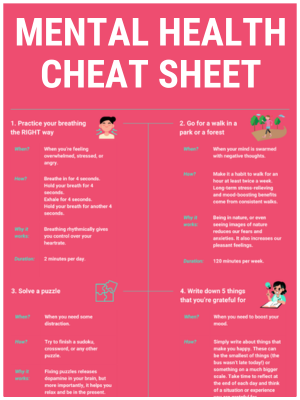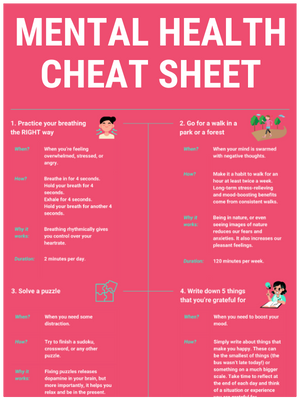What do toddlers and teenagers have in common? Stereotypically, they have a reputation for being… well… terrible. With such a significant age gap between these two groups, you may be wondering why anyone would liken them to each other.
Toddlers and teenagers both experience difficulty managing their emotions, but they struggle for different reasons. Developmentally, toddlers are too young to communicate their wants and needs. They also lack the reasoning skills necessary to cope with negative feelings. Teenagers have a broader vocabulary and a stronger sense of logic, but they must endure the horror of all horrors: puberty. And its accompanying mood swings.
In this article, I will articulate what it means to be emotionally stable, unpack its importance, and share 7 tips to assist you on your road to emotional stability.
Contents
What does it mean to be “emotionally stable”?
Being emotionally stable might seem like a self-explanatory term, but it’s actually rather nuanced.
According to the American Psychological Association, emotional stability is defined as “predictability and consistency in emotional reactions, with absence of rapid mood changes.”
Being emotionally stable doesn’t mean you never feel anything – or that you are always content. It just means that when you do find yourself in emotionally challenging situations, you respond in a reasonable, expected way while maintaining a sense of composure.
In other words, you keep it cool. Even if you are deeply affected by something, you don’t allow your emotions to solely dictate your thoughts and behavior; logic has a place in determining them, too.
💡 By the way: Do you find it hard to be happy and in control of your life? It may not be your fault. To help you feel better, we’ve condensed the information of 100’s of articles into a 10-step mental health cheat sheet to help you be more in control. 👇
The importance of emotional stability
One of the most significant benefits of emotional stability is that it paves the way for a person’s independence. Emotionally stable people tend to have a balanced way of perceiving life’s problems, equipping them with the perspective they need to endure all sorts of hardship. Emotionally erratic people, on the other hand, struggle to maintain equilibrium to such an extent that they have difficulty accomplishing ordinary tasks. They often require assistance in situations where emotionally stable adults would not.
A person’s level of emotional stability plays a huge role in their ability to maintain interpersonal relationships. Emotionally stable people tend to be secure, confident, and even-tempered. Generally, they also exhibit a positive demeanor and get along well with others. These traits are imperative to the health of any relationship – personal or professional.
7 tips to become emotionally stable
Because a person’s emotional stability is subjective, it’s difficult to measure and remediate (if necessary). The approach may look slightly different for everyone, but if you don’t know where to start, consider experimenting with the tips below:
1. Allow yourself to feel
In order to become emotionally stable, you must first allow yourself to feel. It’s tempting to compartmentalize negative emotions to avoid experiencing pain.
However, studies show that suppressing emotions has a negative impact on overall well-being. Furthermore, problems can never truly be addressed unless you are first willing to acknowledge that something is wrong.
Allowing yourself to feel doesn’t have to be a miserable affair. There are a variety of pleasant activities you can do to check in with yourself, including the ones listed below:
- Ensure your schedule includes alone time.
- Enjoy a solo meal at your favorite restaurant.
- Keep a journal.
- Take a tech-free walk.
- Talk through difficult feelings with someone you trust.
- Visit a quiet, peaceful, (and relatively private) place where you can think. I recommend botanical gardens, a park, a free museum, or a coffee shop.
Carving out time and space for you to access your emotions is a vital first step on the journey to emotional stability.
2. Reflect on your emotions
Giving yourself permission to feel is a good start, but reflecting on your emotions is where change actually begins. Being able to name your emotions and ask questions to uncover their source will provide you with valuable insight. You may discover that you need to take action, have a conversation, or redirect your thought patterns based on what you learn.
Consider these questions after experiencing an uncomfortable emotional response:
- What specific emotion am I feeling right now?
- What might be the underlying reason for this emotion?
- Is a belief or value of mine being challenged?
- Does this situation remind me of something I’ve experienced before?
- What can I do to better cope with this emotion or situation if it arises again in the future?
Expressing curiosity – instead of shame – is a healthy, constructive way to process intense emotions and work toward greater stability in the future.
If you’re not convinced about self-reflection, here’s an article that dives into more benefits of self-reflection!
3. Focus on physical sensations
It’s impossible to be emotionally stable when your body is physically wound up. For this reason, it’s important to focus on regulating your physical sensations when experiencing emotional turbulence.
A quick, easy way to physically recalibrate yourself is to perform a body scan. Body scanning is a form of mindfulness. Essentially, you focus on different parts of the body one at a time, acknowledge tension or pain as it arises, and breathe through it to release. For further explanation and research regarding the positive effect of body scanning on mental health, check out this article.
When I was a kid, I attended acting camp every summer. Almost two decades later, and I still remember how our director used to guide us through a communal scan before each show. We would lie there on the stage, silent, in complete darkness, and wait for her to draw our attention from one body part to another. This practice seemed so strange to me at the time, but even so, I know the reason why this memory has stuck with me for so long: Body scanning was extremely effective in calming my nerves!
Taking deep breaths is also scientifically proven to stabilize the body. When our bodies experience “fight or flight,” the pH level of our blood increases, and we are flooded with stress hormones. Deep breathing reduces blood pressure and calms the nervous system, allowing us to return to a more emotionally stable place.
4. Set boundaries
Setting boundaries can significantly increase your emotional stability – especially when you do it across the board. Some people are hesitant to set boundaries because they don’t want to appear harsh; however, instituting limits with yourself and others is actually an act of love. It protects your overall well-being so you can show up as your best self every day.
If you’re feeling emotionally unsteady and can’t pinpoint why, take a look at the many aspects of your life, one at a time, and ask yourself if you need to create or adjust any boundaries. Consider the types listed below:
- Emotional/relational.
- Financial/material.
- Intellectual/spiritual.
- Physical/sexual.
- Time.
Perhaps you feel overwhelmed because you’ve overbooked yourself. Or you feel stressed because you’ve neglected your budget for far too long. Whatever the circumstance, establishing clearer limits for yourself and others will enhance your joy and lessen opportunities for emotional turmoil.
5. Consult a doctor
Some emotional irregularities are biological – not just situational. In this case, you should consult a doctor. Some people worry about the stigma or side effects of taking medication to stabilize your mood, but depending on your unique circumstances, it may be the best option for you.
It’s worthwhile to keep an open mind; it could dramatically improve your quality of life. Similarly, we’ve written an entire article about how seeking help can improve your happiness.
6. Practice gratitude journaling
Cultivating a habit of gratitude can significantly boost your emotional stability. Start by maintaining a daily gratitude journal. Each day, take a moment to write down three things you are grateful for. These can range from simple pleasures to significant accomplishments.
The act of writing them down shifts your focus from negative or overwhelming emotions to positive aspects of your life, promoting a more balanced emotional state.
Gratitude journaling doesn’t just provide temporary relief; it reprograms your brain to notice and appreciate the positives more readily, leading to long-term emotional resilience. Whenever you’re feeling emotionally turbulent, refer back to your journal. This reflection can serve as a powerful reminder of the good in your life, anchoring you in positivity and providing a broader perspective on your emotional experiences.
7. Engage in creative expression
Creative activities like painting, writing, music, or crafting can be therapeutic tools for emotional stability. Engaging in a creative process allows you to express emotions that might be difficult to articulate verbally.
It’s a form of non-verbal communication with yourself, a way to process and make sense of your feelings.
Start by dedicating a small portion of your day to a creative activity that resonates with you. It’s not about the end product but the process of expressing yourself. This creative outlet can provide a sense of accomplishment and joy, countering negative emotions. Over time, these activities can become a safe haven for you, a place to retreat and recalibrate your emotions whenever you feel overwhelmed.
💡 By the way: If you want to start feeling better and more productive, I’ve condensed the information of 100’s of our articles into a 10-step mental health cheat sheet here. 👇
This Cheat Sheet Will Help You Be Happier and More Productive
Thrive under stress and crush your goals with these 10 unique tips for your mental health.
Wrapping up
No matter where you’re at in life, emotional stability is something you can and should continuously pursue. It may require challenging introspective work, but you owe it to yourself and others to work toward a world where emotion and logic function together in perfect harmony.
Is there something you do to stabilize your emotions when you’re feeling uneasy? I’d love to hear from you in the comments below!



